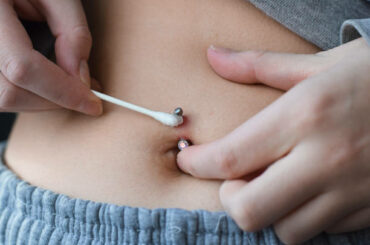Vertical labret piercings have recently gained popularity as a fashionable form of self-expression. However, along with the aesthetic appeal, it’s important to understand the potential consequences, such as the formation of vertical labret scars. These scars are a natural part of the healing process after a vertical labret piercing.
A vertical labret scar is the mark left behind once the piercing has fully healed. It is the body’s way of repairing the tissue punctured during the piercing procedure. The vertical labret piercing involves inserting jewelry through the bottom of the lower lip and exiting vertically through the center of the upper lip.
While the idea of a visible scar may raise concerns for some individuals, it’s essential to consider various factors that can influence the appearance and size of the scar. The process of scar formation can vary depending on factors such as individual healing capabilities, the quality of the piercing procedure, and aftercare practices.
Understanding the nature of vertical labret scars and how they develop is crucial for individuals considering this type of piercing. By being well-informed, individuals can make educated decisions and take the necessary steps to minimize scarring and ensure proper healing.

Contents
Causes of Vertical Labret Scarring
Vertical labret scars can be attributed to several factors influencing the healing process after getting a vertical labret piercing. These factors include trauma during the piercing process, improper aftercare practices, and individual healing capabilities.
1. Trauma during the piercing process:
During the piercing procedure, the tissue is punctured to insert the jewelry. If a professional or experienced piercer does not perform the piercing, it may result in excessive trauma to the area. Rough handling, incorrect placement, or improper tools can lead to more significant tissue damage, increasing the likelihood of scarring.
2. Improper aftercare practices:
Aftercare plays a crucial role in the healing of any piercing. Failure to follow proper aftercare instructions can impede the healing process and contribute to the formation of scars. Neglecting to clean the piercing regularly, using harsh cleaning agents, or touching the piercing with unclean hands can introduce bacteria and lead to infections or complications that may result in scarring.
3. Individual healing capabilities:
Everyone’s body responds differently to piercings and the healing process. Some individuals naturally predispose to form more noticeable scars, while others may heal with minimal scarring. Genetics, overall health, and the body’s ability to regenerate and repair tissue can influence the formation and appearance of vertical labret scars.
Appearance and Characteristics of Vertical Labret Scars
Vertical labret scars can vary in size, visibility, and potential complications. Understanding these aspects can provide individuals with a realistic expectation of what to anticipate after the healing process of a vertical labret piercing.
1. Size and visibility variations:
The size of a vertical labret scar can vary depending on several factors, including the individual’s healing capabilities and how well the piercing was cared for during the healing process. Generally, well-healed vertical labret scars tend to be relatively small and discreet. However, some individuals may naturally develop more prominent scars due to their unique skin composition and healing response.
The visibility of a vertical labret scar also varies among individuals. Skin tone and texture can influence how noticeable the scar appears. Lighter skin tones may exhibit more visible scarring, while darker skin tones may show less contrast, making the scars appear less prominent.
2. Possible complications such as hypertrophic or keloid scars:
While most vertical labret scars heal without complications, certain types of scar formations are possible, such as hypertrophic or keloid scars. These are raised, thickened, or discolored scars that can occur due to an overproduction of collagen during the healing process.
Hypertrophic scars are raised scars that remain within the boundaries of the original wound. They may gradually diminish but can take longer to heal than regular scars. Keloid scars, on the other hand, extend beyond the boundaries of the original wound and may continue to grow even after the healing process is complete.
It’s important to note that hypertrophic and keloid scars are less common and may require specific treatment or interventions. Consulting with a professional piercer or dermatologist can guide individuals on managing or minimizing the appearance of such complications if they occur.
Prevention and Minimization of Vertical Labret Scars
Proactive measures and diligent care can prevent or minimize Vertical labret scars. Considering the following practices, individuals can promote healthy healing and reduce the likelihood of significant scarring.

1. Choosing a professional and experienced piercer:
Selecting a reputable and experienced piercer is crucial for minimizing the risk of complications and scarring. A professional piercer will have the knowledge and expertise to perform the piercing correctly, reducing the likelihood of excessive trauma or improper placement. Research and seek recommendations to find a trusted piercer who follows strict hygiene standards and uses sterilized equipment.
2. Following proper aftercare instructions:
Aftercare is vital for healing a vertical labret piercing and can significantly impact the formation of scars. It is important to follow the aftercare instructions provided by the piercer. This typically involves cleaning the piercing regularly with a saline solution or a recommended cleaning agent. Avoid touching the piercing with unclean hands, and refrain from twisting or playing with the jewelry. Diligently following the recommended aftercare routine can help prevent infections and promote healing.
3. Practicing good oral hygiene:
Maintaining good oral hygiene is crucial when healing a vertical labret piercing. Regularly brush your teeth with a soft-bristled toothbrush, including the pierced area. After meals, gently rinse your mouth with a non-alcoholic mouthwash to keep the area clean and free from bacteria. Avoid excessively hot or spicy food, irritating the piercing site and slowing the healing process.
Managing Existing Vertical Labret Scars
If you have an existing vertical labret scar or are concerned about its appearance, there are steps you can take to manage and potentially reduce its visibility. Consider the following approaches to address existing scars from a vertical labret piercing:
1. Consulting with a professional piercer or dermatologist:
Seeking advice from a professional piercer or dermatologist is recommended when dealing with existing scars. These experts can assess your situation and provide personalized recommendations based on their expertise. They can evaluate the scar’s characteristics, suggest appropriate treatments or techniques, and offer guidance on scar management.
2. Exploring scar management techniques:
Various scar management techniques can help minimize the appearance of vertical labret scars. These may include silicone scar sheets or gels, which can help flatten and soften the scar tissue over time. Massaging the scar with gentle, circular motions using moisturizers or specialized scar creams can also promote blood circulation and improve the scar’s texture and appearance. However, it’s important to follow the instructions provided by professionals and be patient, as scar improvement takes time.
3. Addressing concerns and seeking appropriate advice:
If you have concerns about your vertical labret scar, addressing them and seeking appropriate advice is essential. Consulting with a professional can provide peace of mind and guidance on the best course of action, whether it’s about the scar’s visibility, discomfort, or related issues. They can offer further insights, recommend additional scar management techniques, or suggest alternative treatments.
Conclusion
Proper care and professional guidance are essential for vertical labret piercings and managing potential scars. By prioritizing scar prevention and seeking professional help, individuals can promote optimal healing and minimize the visibility of scars.
Choosing a professional and experienced piercer who follows strict hygiene practices and performs the piercing correctly is crucial. Following proper aftercare instructions, such as regular cleaning with a saline solution, refraining from touching or playing with the jewelry, and practicing good oral hygiene, reduces the risk of complications and scarring.
If a vertical labret scar does develop or concerns arise, consulting with a professional piercer or dermatologist is highly recommended. These experts can provide personalized guidance, evaluate the scar’s characteristics, and offer specific treatments or scar management techniques to minimize its appearance.

It is important to understand that scar management is a journey, and results may vary. Patience, consistency, and adherence to professional advice are key. By prioritizing scar prevention and seeking professional help, individuals can enhance the healing process, reduce scarring, and achieve the best possible outcome.
More Posts :
Bridge Piercing Scars: Empower Yourself with Effective Treatment and Prevention Methods in 2023
Piercing Sidearms Bugged: A Personal Encounter with the Dangers of Faulty Equipment (2023)
The Rise of Board Game Tattoos: Embracing Personal Expression in 2023





